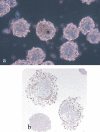Embryonic stem cells
- PMID: 14871235
- PMCID: PMC6495712
- DOI: 10.1111/j.1365-2184.2004.00298.x
Embryonic stem cells
Abstract
Embryonic stem cells have huge potential in the field of tissue engineering and regenerative medicine as they hold the capacity to produce every type of cell and tissue in the body. In theory, the treatment of human disease could be revolutionized by the ability to generate any cell, tissue, or even organ, 'on demand' in the laboratory. This work reviews the history of murine and human ES cell lines, including practical and ethical aspects of ES cell isolation from pre-implantation embryos, maintenance of undifferentiated ES cell lines in the cell culture environment, and differentiation of ES cells in vitro and in vivo into mature somatic cell types. Finally, we discuss advances towards the clinical application of ES cell technology, and some of the obstacles which must be overcome before large scale clinical trials can be considered.
Figures


Similar articles
-
Pluripotent stem cells--model of embryonic development, tool for gene targeting, and basis of cell therapy.Anat Histol Embryol. 2002 Jun;31(3):169-86. doi: 10.1046/j.1439-0264.2002.00388.x. Anat Histol Embryol. 2002. PMID: 12479360 Review.
-
Potential of embryonic stem cells.Mol Aspects Med. 2001 Jun;22(3):149-64. doi: 10.1016/s0098-2997(01)00006-1. Mol Aspects Med. 2001. PMID: 11470141 Review.
-
Whole-blastocyst culture followed by laser drilling technology enhances the efficiency of inner cell mass isolation and embryonic stem cell derivation from good- and poor-quality mouse embryos: new insights for derivation of human embryonic stem cell lines.Stem Cells Dev. 2008 Apr;17(2):255-67. doi: 10.1089/scd.2007.0157. Stem Cells Dev. 2008. PMID: 18447641
-
Embryonic stem cell lines of nonhuman primates.ScientificWorldJournal. 2002 Jun 26;2:1762-73. doi: 10.1100/tsw.2002.829. ScientificWorldJournal. 2002. PMID: 12806169 Free PMC article. Review.
-
Embryonic stem cells: a perspective.Novartis Found Symp. 2005;265:98-103; discussion 103-6, 122-8. Novartis Found Symp. 2005. PMID: 16050252 Review.
Cited by
-
In Vitro, In Vivo and Ex Vivo Models for Peripheral Nerve Injury and Regeneration.Curr Neuropharmacol. 2022;20(2):344-361. doi: 10.2174/1570159X19666210407155543. Curr Neuropharmacol. 2022. PMID: 33827409 Free PMC article. Review.
-
Stem cell-based regenerative medicine.Stem Cell Investig. 2019 Jul 18;6:19. doi: 10.21037/sci.2019.06.04. eCollection 2019. Stem Cell Investig. 2019. PMID: 31463312 Free PMC article. Review.
-
Reprogramming of skin fibroblasts by 3D spheroid culture promotes peripheral nerve regeneration via the ID3/semaphorin7a pathway.Stem Cells Transl Med. 2025 Mar 18;14(3):szaf005. doi: 10.1093/stcltm/szaf005. Stem Cells Transl Med. 2025. PMID: 40213860 Free PMC article.
-
Diabetes-associated macrovascular complications: cell-based therapy a new tool?Endocrine. 2013 Dec;44(3):557-75. doi: 10.1007/s12020-013-9936-8. Epub 2013 Mar 30. Endocrine. 2013. PMID: 23543434 Review.
-
Stem cell technology for the treatment of acute and chronic renal failure.Transl Res. 2010 Sep;156(3):161-8. doi: 10.1016/j.trsl.2010.07.005. Epub 2010 Jul 30. Transl Res. 2010. PMID: 20801413 Free PMC article. Review.
References
-
- Abe K, Niwa H, Iwase K, Takiguchi M, Mori M, Abe SI, Abe K, Yamamura KI (1996) Endoderm‐specific gene expression in embryonic stem cells differentiated to embryoid bodies. Exp. Cell Res. 229, 27. - PubMed
-
- Ali NN, Edgar AJ, Samadikuchaksaraei A, Timson CM, Romanska HM, Polak JM, Bishop AE (2002) Derivation of type II alveolar epithelial cells from murine embryonic stem cells. Tissue Eng. 8, 541. - PubMed
-
- Amit M, Carpenter MK, Inokuma MS, Chiu C‐P, Harris CP, Waknitz MA, Itskovitz‐Eldor J, Thomson JA (2000) Clonally derived human embryonic stem cell lines maintain pluripotency and proliferative potential for prolonged periods of culture. Dev. Biol. 227, 271. - PubMed
-
- Amit M, Margulets V, Segev H, Shariki K, Laevsky I, Coleman R, Itskovitz‐Eldor J (2003) Human feeder layers for human embryonic stem cells. Biol. Reprod. 68, 2150. - PubMed
Publication types
MeSH terms
LinkOut - more resources
Full Text Sources
Medical

